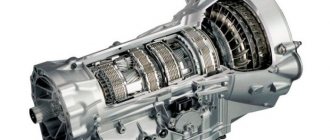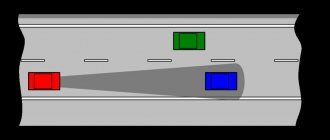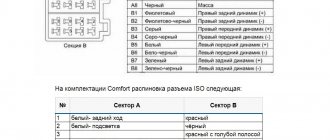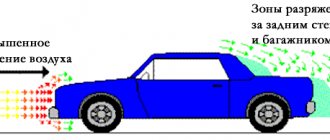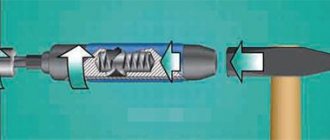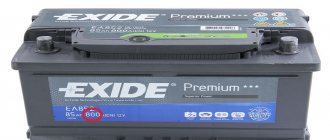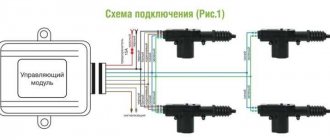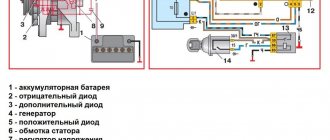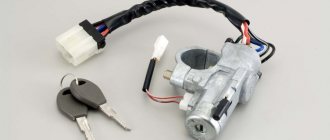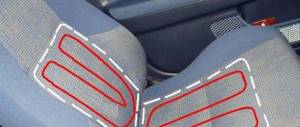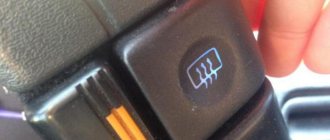How to visually distinguish a CVT from an automatic
All types of gearboxes, both manual, automatic and CVT, could be installed on the same model.
One car model with different transmission options.
Therefore, it is difficult to distinguish the box by car model. You need to start with the documents for the car and inspecting various nameplates and plates:
- If the letters CVT appear, it means that in front of you is a car with a CVT transmission.
- The symbols AT or A indicate a conventional automatic transmission.
Inspect the gear selector. The machine has the designations PRND-2-L.
On the variator, after D there will be either an L, or no symbols at all.
Get behind the wheel and take a ride. The automatic will shift with slight jerks and with each shift the engine speed will drop slightly. If you look at the tachometer and drive, you will see how the needle picks up speed, and then bam and goes back slightly. The variator will have a smooth increase in speed, without a drop.
Stop on a slight slope and release the brake. The automatic car will start moving immediately, without pressing the gas pedal. A car with a CVT transmission will roll back and start moving only after pressing the gas pedal.
Mechanical Differences
The CVT and automatic transmission are the same in that both options are a type of gearbox that is controlled by an electronic device built inside the box. The difference is in the design features.
VKPP
VKPP in technical documentation is designated as CVT (CVT). This is an abbreviation for the English words: “Continuously Variable Transmission”. In Russian it sounds like this: “constantly changing gears”
The difference between a CVT and an automatic is in the structure of the mechanism. The first difference that generalizes all CVTs is in the principle of operation: the absence of gear steps. Speeds change due to the gear ratio. The latter is controlled by parallel cone pulleys. This is a driven and driven mechanism.
There is also a difference in the fastening of the pulleys. Some pulleys in a vehicle's CVT box are connected to each other by means of metal chains, others by means of belts.
The variator works on the principle of moving pulleys apart and bringing them closer together. These actions lead to a change in the gear ratio. And changing the number accordingly changes the speed of the car.
Read
Reviews on the operation and repair of an automatic transmission on a Chevrolet Lacetti
An example of the operation of a V-belt variator in the form of a table:
| Vehicle speed | Locating the pulley in the variator space | Diameter that the belt goes through |
| Low gear (first speed) | Maximum spread | Small |
| High gear (fourth speed or higher) | Maximum shifted | Big |
Attention! The operating principle of a toroidal variator is to change the roller in relation to the friction disc. These differences will be discussed in the next block.
CVT types
The variator has two types of gearbox:
- V-belt. This variator consists of two pulleys and a belt connecting them. It is so named because the moment the pulleys are connected, the belt becomes V-shaped. The pulleys move by means of a hydraulic drive;
- Toroidal. This type of variator consists of rollers and coaxial disks. When the gear changes, the position of the rollers also changes.
But the difference between a variator and an automatic transmission lies not only in design features. CVT boxes have their positive and negative sides.
Disadvantages and positive qualities of CVT
The positive aspects of the variator are the following features:
- smooth movement of the car, without jerking;
- immediate response to changes in the route landscape: slope, country road;
- there is no slowdown in speed with an instant increase in load, unlike an automatic transmission;
- simple design and light weight;
- saving gasoline.
But no matter how much one lists the positive aspects of a gearbox without gear shifting, a vehicle with a CVT still has disadvantages:
- rapid wear of internal CVT equipment (the belt must be changed every 70,000 km);
- the vehicle is not able to move on hilly terrain due to the unsuitability of the variator for heavy loads. Not installed on SUVs;
- Service centers do not repair the variator due to the shortage of spare parts and the complexity of repairs, but only replace one box with another. The gearbox itself is expensive;
- It takes some time to switch the movement back or forward, which cannot be said about the automatic transmission. Many drivers don't like this.
Attention!
Therefore, when choosing a variator, you need to understand that it is short-lived, unlike an automatic.
Automatic transmission
In addition to the variator or robotic gearbox, an automatic transmission is installed in the car. The difference is in the complexity of the design, but it is more durable. This is the main difference between a CVT and an automatic, which is why many experienced car owners buy a car with an automatic transmission.
Read
Which is better and more reliable, CVT or automatic?
An automatic machine, unlike a CVT, consists of the following parts:
- torque converter;
- centrifugal pump;
- overrunning clutch;
- locking clutch;
- planetary gearbox.
The torque converter acts as a clutch and facilitates smooth gear shifting. The automatic transmission gearbox is responsible for the joint operation of all gears.
Types of automatic transmission
The difference between an automatic transmission and a CVT is that an automatic transmission has several gear shift stages:
- four-stage. First released in 1930 and used on some cars;
- six-speed, seven-speed and currently they are already producing cars with a 9-speed automatic transmission. Used on all modern cars.
Defects and positive qualities of automatic transmission
An automatic transmission has its disadvantages and advantages. The positive aspects of a car with an automatic transmission include:
- when stopping on a hill, the car will not reverse;
- reliability;
- comfort in management.
Disadvantages of the machine:
- there is no smoothness when changing gears while accelerating the car;
- expensive maintenance;
- It is not possible to start the engine from a pushrod.
Despite the negative aspects, an automatic transmission works much longer than a CVT.
Analysis of comparison of two boxes
The differences between a CVT and an automatic are not only in the writing of the names of the boxes in technical documents:
- A or AT – abbreviated name of the machine;
- CVT is the name of the variator.
Their differences are noticeable from the following points of view:
- economic;
- reliability;
- appearance.
Read
Typical problems and repairs of automatic transmission f4a42
The question is brewing - why know this and what is better, an automatic or a CVT?
If you buy a new car under warranty, then there is no difference. The only difference is that the consumption, acceleration dynamics and elasticity of the ride will be better with a CVT. The situation changes dramatically when choosing a used car.
The resource of a CVT transmission is longer than that of a conventional automatic transmission. So does the cost of repairs. Usually, by 100,000 km, a CVT already requires expensive maintenance (belt replacement), whereas, like a regular automatic, it requires timely careful maintenance (oil change and gentle driving modes).
In conclusion, there is a large video comparing an automatic transmission and a CVT; the video fully describes the principles of operation of a particular transmission and collects all the pros and cons:
Make smart purchases, make smart choices.
Design and operation of an automatic transmission
Automatic transmission torque converter diagram
The main components of an automatic transmission are a torque converter device, as well as a mechanical gearbox. The first node is used as a clutch, and the second is designed to transmit mechanical force between gears.
Torque is transmitted from the power unit shaft by a torque converter device that operates based on transmission fluid pressure. The design of the automatic transmission includes metal discs with friction clutches and clutches. They are used as a mechanical clutch function. When the discs are compressed and unclenched, certain clutches are activated. The latter are used as gears in the unit.
What can break?
User Alexander Sorokin showed in his video how an automatic transmission is disassembled and repaired.
What malfunctions are typical for automatic transmissions:
- Failure of the automatic transmission lever. Such problems are more typical for old-type units, in which there is a mechanical connection between the gearshift knob and the transmission itself. A breakdown of the link leads to the fact that the car owner cannot switch operating modes of the box. To solve the problem, you will need to change the failed lever, as well as the rocker itself. Signs of a breakdown include difficulties in switching the gearbox selector; in extreme cases, it will be impossible to move the lever to another position. There is a need to repair the unit. In some cars, this requires completely removing the transmission.
- Leakage of working fluid. According to reviews from car enthusiasts, they often encounter the problem of oil leaking from under the rubber seals. Therefore, the owner must periodically perform visual diagnostics of the condition of the transmission in a pit or overpass. When the check shows traces of oil leaks, you need to determine the cause of the leak or contact a service station. If the problem lies in the seals, then they can be changed without difficulty.
- Malfunctions in the operation of the control module. If the central processor breaks down, it may incorrectly select the speed to change speeds. In some situations, the control mechanism blocks the operation of the gearbox. If the module is completely damaged, it must be replaced. If the control cables are damaged, they also need to be replaced. When the central processor is working normally, but sometimes malfunctions occur, you can try to reflash it. But not every specialist is capable of performing such a task.
- Malfunction of the hydraulic unit. Problems occur as a result of wear of the structural elements of the device or non-compliance with the rules for using the unit. If the car owner does not warm up the gearbox in the cold season, but immediately starts driving, and moves abruptly, this leads to malfunctions in the operation of the valve body. The main symptoms are shocks, impacts and vibrations. Sometimes driving a car is completely impossible.
- Malfunctions in the operation of the torque converter device. This problem cannot be solved without repair. It is easier and cheaper to repair a torque converter than a control module or hydraulic unit. If the unit malfunctions, the driver will hear knocking, rustling, and vibration uncharacteristic of the transmission. You will feel that the vehicle's dynamics have deteriorated. And if you change the transmission fluid, you will see a large amount of metal shavings in the oil pan.
Advantages and disadvantages
Let's start with the pros:
- Automatic machines are more reliable units. On average, the service life of a modern automatic transmission is at least 300 thousand kilometers if the box is used and maintained correctly. Moreover, a car with automatic transmission can operate in any conditions.
- Easier repair compared to a CVT transmission. Automatic transmission servicing can be done in a garage. Finding a qualified specialist for this will not be difficult. Moreover, the cost of performing the work will be lower.
- Automatic units are less demanding on the quality of the lubricant used. It is advisable to use original oils, but not necessary. If necessary, you can always find a cheaper analogue.
- Gentle relationship between the automatic transmission and the engine. Switching modes in the transmission operation is carried out without the need to increase the engine speed.
- Less electronics compared to a CVT.
Channel AUTOSALON First Video AutoMarket in its video examined in detail all the pros and cons of CVT gearboxes.
Disadvantages of automatic transmissions:
- Lower efficiency, which is due to its losses in the torque converter device. Accordingly, classic automatic machines do not use all the useful engine power.
- Increased fuel consumption.
- When switching modes, jerks appear in the operation of the transmission unit. Newer cars do not have this problem because they have more gears.
- Not as high dynamic features as CVTs. A vehicle with an automatic accelerates much slower than a car with a manual or CVT.
- Automatic transmissions use more transmission fluid. If a CVT transmission requires 5-8 liters of oil for optimal operation, then a classic automatic transmission will require at least 8-10 liters of lubricant.
Pros and cons of a variator
We will compare CVT with an automatic transmission, since the robot, as mentioned above, is mechanical, and other types of transmission are not so popular.
Main advantages of CVT:
- No shocks or jerks during movement.
- The engine operates with a smooth change in power depending on the situation.
- Virtually an infinite number of gears, which allows for optimal fuel consumption.
- Low noise level during operation.
- High controllability and response.
- Competent optimization of all vehicle running systems.
Now about the disadvantages. The most important of them is the high cost of repairs, since the design of the device consists of many expensive elements. It must also be said that in our country there are very few service centers that undertake such work.
In addition, about ten liters of special oil, necessary for proper operation of the transmission, should be periodically poured into the variator. This liquid is quite expensive and is sold either at company representative offices or in specialized salons. You understand that such salons are not available in every city. In some cases, to reduce repair and maintenance costs, the best choice would be to purchase a contract CVT.
